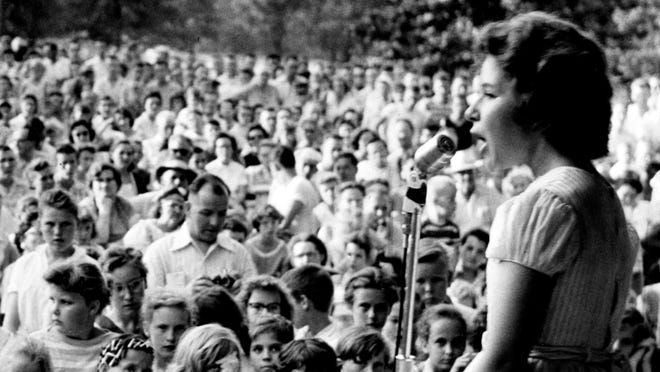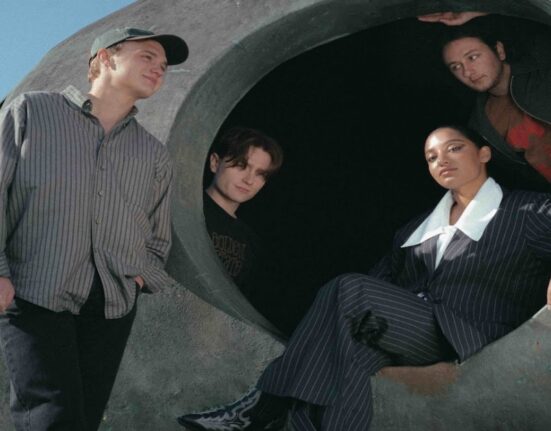
Brenda Lee has rocked around Christmas trees for 64 years.
However, that scratches the surface of why the famously under 5-foot-tall, 78-year-old legend is a Country Music and Rock ‘n’ Roll Hall of Famer responsible for selling over 100 million records worldwide.
She’s a prodigal pop talent whose ability to seamlessly weave gospel and jazz stylings into country, rockabilly and rock ‘n’ roll allowed the genres to become global juggernauts within a five-year swing from 1958 to 1963.
During that time, Lee released three top-10 albums and 19 top-10 singles, including “I’m Sorry,” “I Want To Be Wanted,” “All Alone Am I” and “Losing You.”
She’s seated in her West Nashville home and giddily discussing pairing with Tanya Tucker, Trisha Yearwood and, yes, a guest appearance by Santa Claus himself for a music video for her six-decade-old classic.
Via the magic of streaming, “Rockin'” is now nearly a triple-diamond-selling single.
For the last five years, it has created a holiday season stronghold with Mariah Carey’s “All I Want for Christmas Is You” on Billboard’s Hot 100 chart.
Because of this unprecedented acclaim, there’s reason to observe her career as a study of successful concepts and ideas with timeless industry permanence.
‘Rockin’ Around the Christmas Tree’
“Rockin'” was written by Johnny Marks, a Jewish songwriter with a particular affinity for writing seasonal holiday pop songs. He’s so closely tied with Christmas that he even owns the trademark on the character of Rudolph the Red-Nosed Reindeer.
Between 1949 and 1960, his work yielded not just Lee’s “Rockin’ Around the Christmas Tree,” but also “Rudolph the Red-Nosed Reindeer” for Gene Autry, “A Holly Jolly Christmas” and “Silver and Gold” by Burl Ives, plus “I Heard the Bells on Christmas Day” for Bing Crosby.
Lee, then 12, recorded multiple Christmas songs penned by Marks on the same day. She was enamored with the song but is still, nearly seven decades to the day after recording it, surprised by the longevity of its success.
The record’s producer and iconic Nashville creator, Owen Bradley, offered advice about the finished song’s potential that rings true to the present.
“If this song hits it big, it will only be a hit for a few months.”
A 2022 Tennessean story included a digital chart highlighting how “Rockin'” takes three chart cycles in December to achieve its placement at No. 2 behind Mariah Carey’s “All I Want for Christmas.” The week before Christmas 2022 saw Taylor Swift’s “Anti-Hero” slide down the charts as Lee’s single achieved nearly 50% more digital streams during the month.
“This song has been so special to me — I never thought it would be my signature song, but I love that it is because it brings so much joy,” Lee stated in a recent press release. “Here we are 65 years later and I’m only here because of you. I won’t ever meet all of you, but I know you are there and have been since I was a little girl.”
‘We played and sang what we felt’
Lee’s hit songs were stunning successes by any generational standard.
1960’s “I’m Sorry” took eight weeks to ascend to No. 1 on Billboard’s charts. More impressively, the song required only 90 days from being cut to ascend to pop’s pinnacle.
“That was a crazy time that doesn’t exist anymore and I loved it,” says Lee about a schedule that saw her record two albums a year for five years at the turn of the 1960s.
She grew up fast in Atlanta. After her father died when she was 8, her mother remarried. By the time she was 11, she’d gained enough favor in a region as vast as Red Foley’s “Ozark Jubilee” in Springfield, Missouri, to the west, Jimmie Skinner’s bluegrass radio show to the north in Cincinnati, and “The Peach Blossom Special” radio program in east Georgia to sign a deal with Decca Records by 1956.
Engineers, producers, session background singers and musicians, including the previously mentioned Bradley and the Anita Kerr Singers, served as a second family for the child star.
After initially recording a cover of Hank Williams’ “Jambalaya” when signed to Decca, other era cuts included “Rockin’ Around the Christmas Tree,” too.
When asked what motivated her to record so much so well, she’s quick to cite artists not of her pop lane but jazzy classicists, gospel icons and R&B stars, including Ruth Brown, Aretha Franklin, Billie Holiday, Etta James and Mahalia Jackson.
“I recorded songs crafted by great musicians and songwriters — who were my friends — at the peak of their craft,” Lee says. “(They, like me) had foundations in listening to blues, country, gospel, rock and soul. We worked with each other, playing and singing what we felt.”
Maturation via song
Mirroring the work of soul artists twice her age led Lee to sing songs like the Italian-written and English-translated pop song “I Want To Be Wanted,” which featured 16-year-old Lee singing the following words:
“When I am kissed / I want his lips to really kiss me / When we’re apart / I want his heart to really miss me / I want to know he loves me so his eyes are misting / That’s the way I want to be loved”
“People thought I was in my 20s singing those words,” says the legend.

When asked to directly point at the reason why youthful female sophistication became a Nashville-to-global standard expanding from Lee through multiple generations of performers to modern-era stars like Kacey Musgraves, Lee offers one name:
Richard Barstow.
Yes, the choreographer and director of Ringling Brothers and Barnum & Bailey Circus — with experience in Broadway and Hollywood musicals, plus working for Fred Astaire, Judy Garland and Gene Kelly — worked with Lee, too.
“(Barstow) taught me so much about song choices, stage presence, everything — I went from growing up poor, scared to death and not knowing anything to touring the world.”
Brenda Lee, global icon
Lee, like many breakout American pop stars signed to labels with global distribution, was frequently jet-setting back and forth between domestic success and international appeal throughout pop’s early eras and beyond.
As her American appeal grew, she also made nearly a dozen tours of Europe in the same era before 1964’s British Invasion.

In 1962, the Beatles opened for her in Hamburg at the Star Club, where the band initially developed their skills.
“I was floored that they were fans of my music,” Lee says.
As European success melded with South American and Asian appeal, Lee’s ability to combine the art of musical presentation with the skill of song styling keyed her initial success as a top-selling recording artist to evolve into her appeal as a global-touring star.
Lee recalls becoming multilingual enough to perform her star-making material in various languages as an instance where she was “astounded” by how the power of the connectivity of her material transcended language barriers.
She recalls Japanese touring nights — on one of her 30 tours of the nation in her career — where she would curiously and nervously observe crowds patiently watching her performances. Her shows were renowned by acts including Elton John as stunning as those by Janis Joplin and Tina Turner.
“(Because they were so reserved), I didn’t know if they liked me. So, after one show, I decided to do autographs — I signed for two and a half hours,” says Lee, laughing.
Lee’s country years
Lee married Ronnie Shackett in November 1962. She remained busy as a recording artist until turning 25 in 1969.

Lee’s life was a frenetic one, alternating between poverty, wealth and all spaces in between, plus giving birth to two daughters, Jolie and Julie — amid a non-stop cycle of recording and touring.
However, the nature of that schedule beset her with exhaustion and stomach and kidney problems, plus a condition that caused blood clots.
Undeterred, a more Nashville-bound Lee returned to recording by 1973 in Music City’s “countrypolitan” era. On the edge of 30, Lee succeeded again primarily because country music had comfortably discovered how to meld with pop’s existing sensibilities. Moreover, her “mature” material finally had aged into lock-step to where Lee had arrived in her own life.
From 1973 to 1980, Lee released seven albums, featuring nine top-10 country-charting singles.
She describes the confluence of notions that defined the era as making it a “strange” one. However, songs like “Big Four Poster Bed,” Kris Kristofferson-written “Nobody Wins” and Oak Ridge Boys collaboration “Broken Trust” were successful.
Trusting her longtime producer Bradley’s “brilliance” guided her through that period.
“Owen was more than a producer to me,” stated Lee in a 2019 Atlanta magazine interview. “He was a father and a friend who always treated me as an artist and a peer.”
Brenda Lee’s legacy
“I’ve watched and learned from so many greats — everyone from Ella Fitzgerald and Dionne Warwick to the Ronettes and Shirelles with Phil Spector,” Lee says.
While sitting for a photograph in her music room, an Elvis Presley autograph and her Grammy Lifetime Achievement award are within grasp of her hands — she’s had an astonishing career.
Lee makes a point that serves as the greatest testament to the self-determination and work ethic that allows her to continue to top Billboard’s pop charts:
“It’s OK to have an outline of what you’re going to do. But all that stuff in the middle; you need to do it yourself.”






